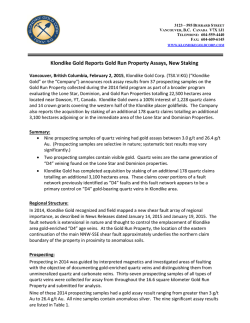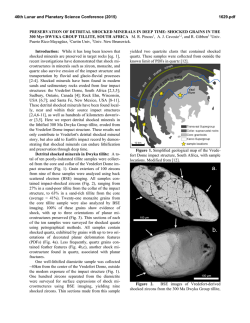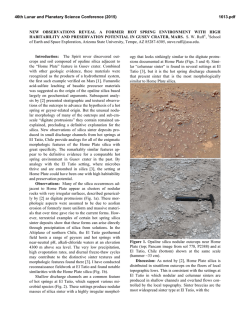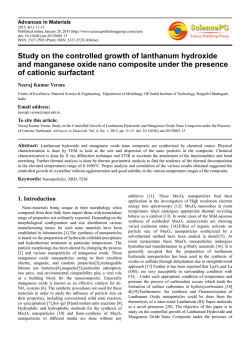
Quantitive analysis of quartz in perlite by x
QUANTITATIVE ANALYSISOF QUARTZ IN PERLITE BY X-RAY DIFFRACTION Chris McKee, Jacques Renault, James Barker New Mexico Bureau of Mines and Mineral Resources 81801 Campus Station, Socorro, NM INTRODUCTION in occupational health for Quartz has been of interest several years, becauseit can cause silicosis. New regulations, is of OSHA (1989) list perlite as a nuisance dust, and this particular interest in New Mexico, because 85 % of the perlite produced in the United States is mined in this state. In order well being of the public using New Mexico to better assure the products, the New Mexico Bureau of Mines and Mineral Resources has begun a program to improve the sensitivity and accuracy of low level quartz determinations in perlite. newOSHA regulations conclude that perlite is nontoxic The when airborne total particulate concentrations are 15 mg/m3 or is less than 1 below and when crystalline silica concentration weight % .The agency has established an 8-hour permissable expo- sure level (PEL) of 15 mg/m3 time weighted average (TWA) for 1 total perlite dust containing less than % quartz, and has established a 5 mg/m3 TWA PEL for respirable perlite. These of eye, skin, limits will protect workers from significant risk or other physical irritation. This regulation is based on a Group 2A classification as a probable carcinogen in humans, at the 0.1 % crystalline silica level, by the International Agency for Research Cancer (IARC). IARC (1987a,b) found Sufficient 1 evidence for carcinogenicity of crystalline silica in animals and limited evidence in humans. Perlite is not listeda carcinogen as by OSHA or the National Toxicology Program. Free silica commonly occurs in perlite in trace amounts. Crystalline silica can occur as several polymorphs. The most common polymorphs are quartz, cristobalite, and tridymite. in perlite, Quartz is the only common form of crystalline silica so initial research concentrated on the quartz content of perlite (Hamilton and Peletis,1988). Early attempts to analyze rocks for free quartz included the and Wynne, 1940 potassium pyrosulfate digestion method (Trostel and Gysin and Reelf, 1951 and 1952). Other methods include optical microscopy and heavy liquid separation (Hamilton and Peletis, 1988). All these methods are time consuming and lack the required precision and accuracy to meet both OSHA and IARC thresholds. Traditional XRD analysis of quartz in industrial dusts uses 1974) that are well-established procedures (Klug and Alexander, 1 sensitive to quartz at the % level. With the new regulations, sensitivity is required at the 0.1 % level. As existing analyt- ical methods could not adequately determine quartz this at new level, Mansville Sales Corporation initiated the development of in perlite at the0.1 an XRD method to determine quartz % concen- tration (Hamilton and Peletis,1988 and 1989). Work at the New Mexico Bureau of Mines and Mineral Resources (NMBMMR) confirmed 1989). The the work of Hamilton and Peletis (Barker and Mckee, 2 present report will discuss continuing research at the NMBMMR on the determination oflow levels of quartzin perlite. SAMPLE PREPARATION Sample preparation is important in XRD analysis, especially for quantitative work. Unknowns must be representative of the bulk perlite and must be ground very fine. standards and unknowns a reproducible and uniform must be presentedto the x-ray beam in manner. Industrial Standards of their Manville Sales Corporation provided us with seven 1). in-house natural perlite standards (Table The standards were supplied in powder to granular form and ranged in weight 40 from to 15 grams. Five to ten grams of standard were ground for three mill as instructed by minutes in a tungsten carbide ring puck Manville (Hamilton and Peletis,1988). Table 1. Industrial standards (Manville Sales Corp.) STANDARD PA130 PA130 PA130 PA130 PA116 PA610 PA4000 * values REPORTED QUART3 CONCENTRATION ND #1 #2 0.2 ND #3 #4 #5 0.2 0.4 #6 #7 0.1 0.2 are from Hamilton(1989, written communication) 3 Laboratory Standards Laboratory standards were prepared by blending ground window (SOS) quartz sold by Fisher Scienglass and standard Ottawa sand tific. The compositions of these are shown in Table 2 . Window it was convenient and glass was chosen for the standards because because it contains elements (Ca, Na, Fe, Mg)that make it possible to determine the quartz concentration in the standards by chemical analysis. of glass were ground for30 Ten to fifteen gram batches minutes in a model 8000 Spex Mixer/Mill equipped witha tungsten carbide grinding set. Using a Microjet 5 high speed grinderwith a 20 ml. agate mortar and pestle, ten gram batchesSOSofwere SOS were homogenized before mixing. ground. Both the glass and A practical range of quartz concentrations was prepared by 1:l mixture of SOS + glass with repeatedly re-diluting an initial glass in 1:l increments. Prior to each dilution, the mixtures were blended for12 minutes in the Spex Mixer/Mill then split into 10 gm aliquots. The resulting progressionof concentrations is shown in Table 2 . ~ necessarytoprecisely It departs from ideality, becauseit is not mix in a 1:l ratio. ~ ~ ! ~ I Grinding Reproducibility in XRD analyses is dependent on uniform, will decrease the effects fine grain size. Also, small grain size of extinction and microabsorption (Klug and Alexander, 1974). Proper grinding using uniform weights and identical grinding time improves reproducibility. 4 Table 2. Artificial standards prepared from quartz and common glass. STANDARD QUARTZ CONCENTRATION AS MIXED APS50Q APS25Q APS 1 2Q APS6Q APS3Q APSl. 5Q APS. 18Q APS.398 APS. 204 APS lOQ APS .05Q 50.154 25.819 12.317 6.151 3.064 1.510 0.151 0.370 0.181 . 0.0953 0.0411 Several grinding strategies were tried. At first,an alumi- na mortar and pestle was used. Dry grinding in acetone, and grinding in liquid nitrogen were both investigated, but powders produced from each of these methods were too coarse for XRD analysis. While the Microjet 5 grinder can producea finegrained powder in a short time, the agate grinding set may conso the Microjet 5 was not used. taminate the perlite with quartz, The Spex Mixer/Mill was the last grinder tested. Unknowns were ground for thirty minutes using the tungsten carbide grinding set. The Mixer/Mill produces a fine powder, does not contaminate the samples, and can be dedicated to perlite analysis alone. 1/1OOp, Brindley and Brown's ( 1980) maximum size criterion of where p is the mean linearabsorption coefficient of the particles gives approximately2 5 pm as the maximum allowable particle size for quantitative clay analysis. our samples are not clays, and their particle sizeis something less than 20.pm; however, we 5 feel that our observed intensity errors are acceptable in view of to decrease the increased grinding time that would be required particle size bya factor of 10. Briquetting is to achieve reproduciThe purpose of briquetting samples ble presentation of the powder sample to x-ray the beam. Because preferred orientation does not seem toa problem be with analysis of quartz in perlite, the use of this method has two advantages: 1 ) sample preparation is rapid, and 2 ) the XRD sample can be ana- lyzed by x-ray fluorescence spectroscopy without a further sample preparation step. (1963). The briquetting die used was designed by Volborth We modified the die by inlaying a polished disk of silicon carbide in its anvil. It producesa briquette with an analytical surface 30 mm in diameter. Standards were split, and1.0 gram of each weighed out. The powder was introduced into the briquetting die and backed with boric acid. The sample was then compressed under a five-ton load of deionized water and the die disassembled. One to three drops of the pellet and allowed were placed on the analytical surface to soak in. The water helps drive out entrained air and improve intergranular adhesion of grains. The die was reassembled and a twenty ton load. Figure 1 the sample was compressed under graphically shows the reproducibility of duplicate standard briquettes containing 0.2 % quartz. 6 88.00 84.00 4 DUPLICATE STANDARDS WITH IN COMMON GLASS. 0.2% QUARTZ A :80.00 0 W & 76.00 v, Z 72.00 Z - . .. 1 68.00 64.00 26.00 26.20 26.40 26.60 27.00 26.80 2-TH ETA Figure 1. Reproducibility of duplicate briquettes SAMPLE ANALYSIS Samples were analyzed on a Rigaku D/MAX diffractometer controlled by a DEC PDP 11/23 computer using themanufacturer’s software. The diffractometer is equipped with a long, fine focus, Cu X-ray tube, graphite.monochromator, and a scintillation coun- ter. Machine and slit settings are shown in Table 3. Pellets were mounted in the sample spinner designed by Renault (1984). At the beginning of each run of several standards, a pureSOS pellet was run to correct for drift and to serve as an instrumental standard. Figure 1 graphically shows the reproducibility of0.20% quartz in duplicate pellets. in Table 3. The difThe instrumental conditions are given fractometer was set-up to step scan over (101) the quartz peak at 26.66 degrees two-theta (Cu radiation). Considerations of con- venience and counting statistics led us to adopt the machine 3 which allow one analysis per hour of settings given in Table machine time. under these conditions, the peak intensity of quartz at 0.2 % is about 500 counts and reproducible at the 4 % level. Table 3. Instrumental conditions. MACHINE SETTINGS SLITS - 40 Kv 25 mA 0.01O Step Width 40 Sec./Step 26.2'-"27.0° Scan Range lo -" DS 10 ss 0.30 mm RS 0.30 mm MS Feldspar, mica, clays, and other common minerals in perlite (101) peak of quartz. To check have peaks that overlap with the for possible peak overlap, a scan from three degrees to sixty degrees two-theta is run on unknowns. Peak overlapis evaluated on an individual basis. 8 Raw binary data used by the PDP computer were converted to 5-1/4 ASCII form. Files are then transferred to an IBM PC inch diskette using the communications software, SOFTCOM, developed by The Software Store of Marquette, IL. personal computer to remove The data files were edited a on text and then reduced by the deconvolution program of Wiedman, et al. (1987). This program precisely establishes background and enhances peak resolution without changing the integrated intensity. Good peak resolution is important in the analysis ofunknowns in order to reveal the presenceof interferences. The program of Weidman, et al.(1987) improves resolution by revoving instrumental broadening and minimizing the effects of random 2 shows the deconvolution counting error on deconvolution. Figure and background correction as applied to a laboratory standard with 0.20 % quartz. SOS, serves as an The profile of the pure quartz standard, instrumental standard. Peak areas are integrated because differences in crystallinity require analysis of peak area, not peak height. After peak integration, the counts are normalized toSOSthe 1 integratedcounts.Calibrationcurvesareconstructedusingthe normalized integrated counts versus quartz concentrations. 3 ) and second order (Figure4) Both straight line (Figure calibration curves fit the data reasonably well. The first is fit over the whole range of possible quartz concentrations and the second over a short range low of concentrations. 9 DECONVOLUTED 0.2% QUARTZ LAB STANDARD. DOTS = RAW DATA SOLID LINE = DECONVOLUTION . . . .... . .. 2-TH ETA Figure 2. Deconvolution and background correction for a labora0.20% quartz. tory standard with 4. It is preThe second order curve is shown in Figure ferred for several reasons. It has a lower root mean square (RMS) of residuals (Table4); its intercept is closerto zero it has more practical applicathan the straight line curve; and tion to the quartz concentrations of interest in industrial perlite. 10 100.00 I Intensity ratio with standard Ottawa sand. " Figure 3. Straight line calibration curve of quartz in laboratory standards. 11 Figure 4 . Second order calibration curve for low concentrations of quartz in laboratory standards. Under ideal conditions, the standards should form a first order linear curve with a zero intercept. This is expected when the mass absorption coefficient (MAC) of the matrix equals the MAC of the analyte (Alexander and Klug, 1948). The shape of the second order curve suggests that the MAC of quartz is greater 12 than the MAC of the glass (Alexander and Klug, 1948), but in fact, the glass contains components that make its MAC greater than quartz. No doubt the shape of the calibration curveanisartifact of sample preparation. At higher quartz concentrations, the 3 and 4 . standards have greater spread on figures And far exceed the error due to counting statistics. This variation is probably due to inadequate mixing of the higher quartz standards. As 50% quartz to less than 0.05%, sample preparation progresses from the blending and grinding time of the quartz increases. Consequently, mixing is better for the lower concentrations than for the higher. We suspect that random error introduced by inhomogeneity has biased the countrates of intermediate concentrations % quartz upward and that the mean error introduced at50the level is propagated to lower concentrations. Table 4. STATISTICS FOR THE CALIBRATION CURVES First Order second order RMS Precision LLD 25.1 % 16.9 % 0.05 % 60.6 % 32.1 % 0.20 % RMS = Root mean squareof residuals Precision at 0.1 %level. LLD calculated at 3u. I Precision at the 0.1 % level is 16.9 % (table 4). The lower limit of determination at three sigma is 0.05 % (table 4). Accu- well-characterized racy can not be determined until a ofset standards are available. 13 SUMMAaY The method presented in this paper has good precision, is as rapid as can be expected with ordinary X-ray tube power, and can 0.1 detect quartz in perlite at the % level. The samples can be in a reproducible manprepared and presented to the x-ray beam ner. Future researchwill include the study of the effect of affect the variation in mass absorption coefficients and how they calculation of quartz content.A second area of interestwill be to reformulate the laboratory standards to reduce the analytical variation at high quartz concentration.A l s o , a larger set of standards will be produced. natural perlite standIt would be of help to have aof set of different laboratoards that have been analyzed by a number ries and techniques. Improvement in sensitivity is expected to occur at higher x-ray tube power, but expensive equipment is required for that. The method presented here could used also be for cristoba- lite and tridymite if the proper standards areused. This method is also applicable to other materials in addition to perlite. ACKNOWLEDGEMENTS We thank Manville Sales Corporation for providing some of their in-house standards and for help in starting this research. Sue Crum is thanked for helping with sample preparation. The authors are very appreciative for the constructive reviews of 14 this paper by Necip Guven of Texas Tech University and Randall Hughes of the Illinois Geological Survey. REFERENCES Alexander, L., and Klug,H. P., 1948, "Basic Aspects of X-ray Absorption in Quantitative Diffraction Analysis of Powder Mixtures", Anal. Chem. Vol. 20, pp. 886-889. Barker, J. M., and McKee, C., 1989, "Overview of the Impact on the Perlite Industry of IARC Classification of Crystalline 2A (Probable) Carcinogen in Humans",Pre Silica as a Group print 89-184 Brindley, G. W., in clays." - SME Annual Meeting, Littleton, Co., 31 pp. 1980, "Quantitative X-ray mineral analysis of "Crystal Structures of Clays and X-ray their Identification," Mineralogical Society, London, 411-438. p Gysin, M., and Reelfs, D., 1951, "Dosage du Quartz (Silice libre) dans les Silicates, Note Preliminaire", So. Phys. et Hist. Nat. Geneve Vol.4, pp. 245-248. Gysin, M., and Reelfs,D., 1952, "Dosage du Quartz (Silice libre) dans les Silicates, Deuxieme Note", Hist. Nat. Geneve Vol. SOC. Phys. et 5, pp. 181-184. Hamilton, R. D., and Peletis, N. G., 1988, "The Determination of Quartz in Perlite by X-rayDiffractionvt,Unpubl. Rept., Corporate Research and Engineering Center, Manville Sales I 15 ""_ , 1989, "The Determination of Quartz in Perlite by X-ray Diffraction", abst., Denver X-ray Conf., p. 136. IARC, 1987a, "Silica and Some Silicates", IARC Monographs on the Carcinogenic Risks of Chemicals to Humans, Vol. 42, pp. 1-144. _"" , 198733, "Overall Evaluation of Carcinogenicity*', IARC Monographs, Supplement 7, pp. 29-74 and 341-343. Klug, H. P., and Alexander, L. E., 1974, "X-ray Diffraction 966 pp. Procedures." John Wiley and Sons, New York, Kohyama, N., 1985, "A New X-ray Diffraction Method for the in the Airborne Dust Quantitative Analysis of Free Silica in Working Environment", Indus. Health Vol. 23, pp. 221-234. Renault, J., 1984, "Turbine Drive sample Spinner for X-ray Diffraction", Rev. Sci. Instrum. Vol. 55, pp. 805-806. Trostel, L. J., and wynne, D. J., 1940, "Determination of Quartz (Free Silica) in Refractory Clays", J. Amer. Cer. SOC. Vol. 23, pp. 18-22. Volborth, A., 1963, "Total Instrumental Analysis of Rocks", Rep. 5, Nevada Bureau Mines85 pp. Weidemann, K.E., Unnam, J, and Clark, R.K., 1987, 9fDeconvolution of powder diffraction spectra," Powder Diffraction, v.2, pp130-136. -""""" , 1987, "Computer program for deconvoluting powder diffraction spectra," Powder Diffraction, v. 2, pp 137-145. 16
© Copyright 2026




